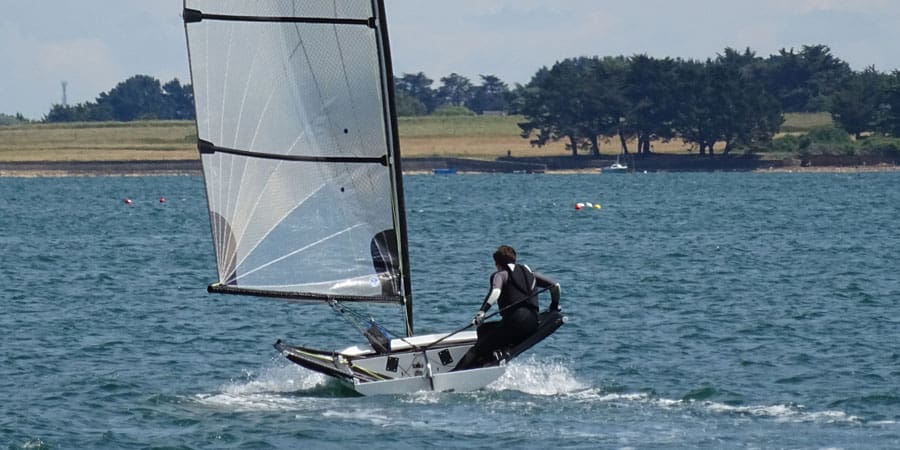TT SCOW is a 5.1m long, hiking, single handed dinghy designed for adults looking to sail on a fast, high specification dinghy.
The prototype was built as an experiment to try new ideas, materials and methods of construction. It has all the main features of the TT SCOW: canting mast, scow hull shape, hiking wings and a spinnaker. To keep things simple, there is no double deck which means that buoyancy bags and bailers are needed in the event of a capsize.
Dual mode hull shape
The hull shape works in two modes: sail it heeled upwind, and waterline length increases, with relatively rounded hull sections to reduce wetted surface area. Sail it flat when reaching, and benefit from a flat bottom for better planning capability.
The scow hull shape provides a number of benefits compared to a standard hull shape:
-More form stability as the beam is constant all along
-No bow down trim when heeled, it means the boat can be pushed harder and is more controllable.
-Less distortion of the hull shape with heel angle for better hydrodynamic efficiency
Canting mast
The mast can be canted to windward when sailing, similarly to what windsurfs do. Upwind, the aim is to sail the boat heeled in order to increase waterline length and cant the mast to windward to offer the sails well into the wind. When reaching, the aim is to sail flat and cant the ring to generate lift up and effectively making the boat lighter.
Canting the mast also means rig weight works to increase stability.
The mast has a small wing section and is unstayed similarly to the Finn dinghy. The sail and mast work together neatly. The canting system works with a self-aligning bearing at deck, and a transverse track at the mast base. A purchase system on each tack allows controlling the cant angle. The two-part mast is easy to transport and the low weight of the tube means one adult can step it alone.
Hiking wings
The hiking wings increase crew lever to provide more stability and therefore carry more sail area. The main control lines lead outboard on both tacks and a slack take-up system allows to keep the cockpit free from excessive ropes. This system is inspired by foiling moth dinghies.
So that wings do not scoop water when sailing, the freeboard is rather high and the wings are angled up to allow for 15 degrees of heel.
The Numbers
Hull Length: 5.1m
Maximum beam (with wings): 2.45m
Hull beam: 1.425m
Displacement: 75kgs
Mainsail area: 11.2 sq.m.
Spinnaker area: 13.2 sq.m.
www.thomastison.com
